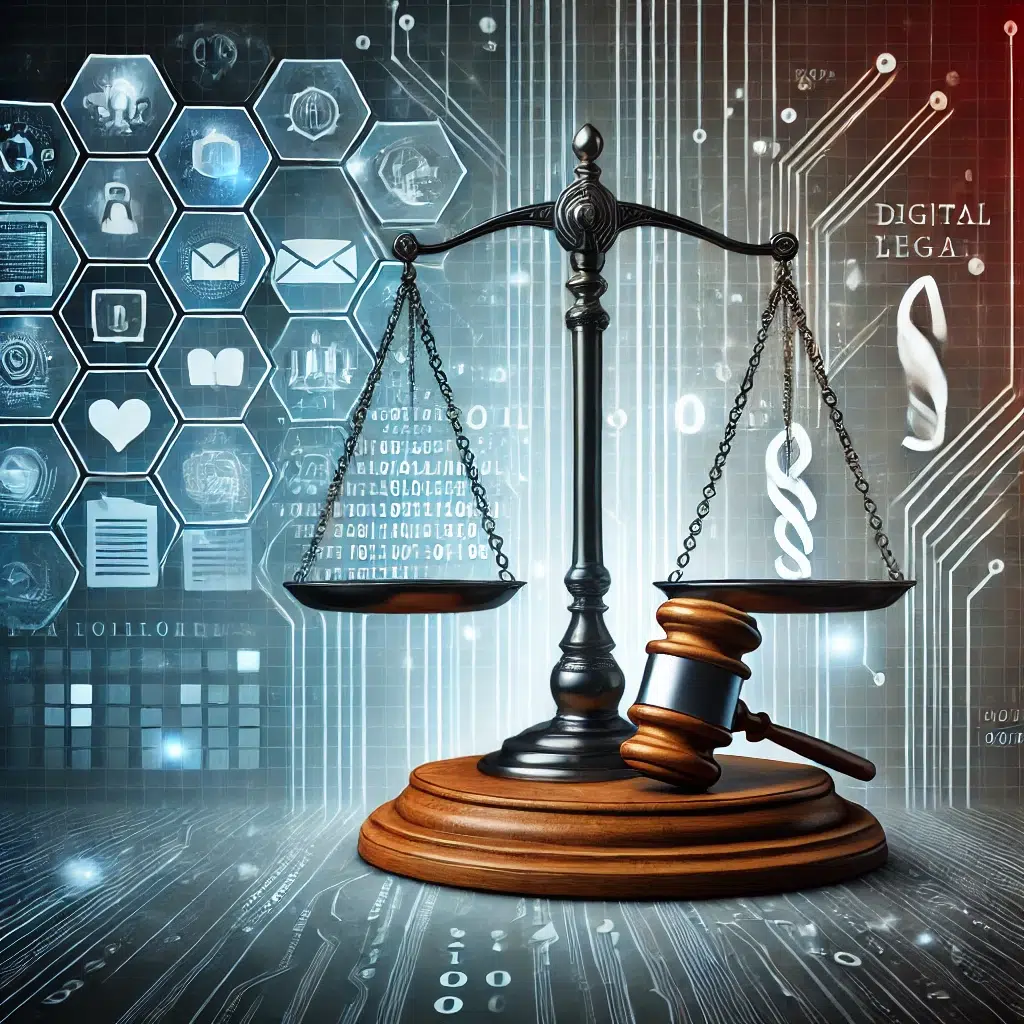In an era where technology intersects with nearly every aspect of life, the legal profession is increasingly challenged to navigate the complex terrain of digital evidence and compliance. The growing reliance on digital data in litigation and investigations necessitates a deep understanding of the legal frameworks that govern the acquisition, handling, and admissibility of this evidence. As legal practitioners, it is our duty to ensure that our approach to digital evidence not only upholds the highest standards of ethical practice but also complies with the intricate web of laws and regulations that govern this domain.

The Complex Legal Landscape of Digital Evidence
The legal landscape governing digital evidence is vast and multifaceted, shaped by a complex interplay of federal and state statutes, judicial precedents, and regulatory frameworks. As the volume and significance of digital data in legal matters continue to grow, so too does the need for legal practitioners to thoroughly understand the myriad legal principles that govern the collection, handling, and use of digital evidence. This landscape is not static; it evolves in response to technological advancements and shifts in judicial interpretation, making it imperative for legal professionals to stay abreast of the latest developments.
Federal Statutes: The Foundation of Digital Evidence Law
At the federal level, several key statutes form the bedrock of legal regulation over digital evidence. Among the most significant are the Electronic Communications Privacy Act (ECPA) and the Computer Fraud and Abuse Act (CFAA). These laws serve as the primary guides for determining the legality of accessing electronic communications and protecting computer systems from unauthorized intrusion.
The Electronic Communications Privacy Act (ECPA)
The ECPA, enacted in 1986, was a groundbreaking piece of legislation designed to extend privacy protections to electronic communications in a rapidly digitizing world. The statute recognizes the growing importance of electronic data and aims to balance the need for privacy with the requirements of law enforcement and legal processes. The ECPA is divided into three main components, each addressing different aspects of electronic communication:
The Wiretap Act: This section of the ECPA prohibits the intentional interception of wire, oral, or electronic communications unless specific exceptions apply. Legal practitioners must be acutely aware of this act’s provisions, as any unauthorized interception can lead to significant legal ramifications, including the exclusion of evidence and potential civil or criminal penalties.
The Stored Communications Act (SCA): The SCA governs the voluntary and compelled disclosure of stored electronic communications and transactional records by third-party service providers. For attorneys, understanding the SCA is crucial when seeking to obtain emails, text messages, or other stored communications from service providers. The SCA imposes strict limitations on when and how such data can be accessed, and failure to comply with these limitations can jeopardize the admissibility of the evidence.
The Pen Register Act: This section regulates the use of pen registers and trap-and-trace devices, which capture dialing, routing, addressing, and signaling information. Although these devices do not capture the content of communications, their use is still subject to stringent legal controls. Legal practitioners must ensure that any use of such devices in their investigations complies with the requirements of the Pen Register Act to avoid legal challenges to the evidence.
The ECPA’s provisions are complex and often intersect with other areas of law, such as privacy rights and Fourth Amendment protections against unreasonable searches and seizures. As such, attorneys must exercise due diligence in understanding the nuances of the ECPA and how it applies to the specific circumstances of their cases.
The Computer Fraud and Abuse Act (CFAA)
The CFAA, enacted in 1984, was initially aimed at addressing the emerging threat of computer-related crimes, such as hacking and unauthorized access to computer systems. Over the years, the CFAA has evolved into a critical tool for both criminal and civil litigation involving digital evidence. The act criminalizes various forms of computer misconduct, including unauthorized access to computer systems, data theft, and the transmission of malicious code.
The CFAA’s broad language has led to its application in a wide range of cases, from prosecuting cybercriminals to resolving civil disputes involving the misuse of digital assets. For legal practitioners, the CFAA serves as both a sword and a shield—providing a basis for legal action against wrongdoers while also setting strict boundaries on how digital evidence can be obtained and used.
One of the key challenges posed by the CFAA is its broad interpretation of what constitutes “unauthorized access.” Courts have grappled with defining the boundaries of authorized versus unauthorized access, particularly in cases where individuals have legitimate access to a computer system but exceed their authorized use. This ambiguity requires attorneys to carefully assess the facts of each case to determine whether the CFAA has been violated.
For example, in the employment context, the CFAA has been invoked in cases where employees access and misuse company data in violation of their employment agreements. However, recent court decisions have narrowed the scope of the CFAA in such cases, emphasizing the importance of clearly defining the terms of authorized access in employment contracts and other agreements.
State Statutes and Judicial Precedents
While federal statutes like the Electronic Communications Privacy Act (ECPA) and the Computer Fraud and Abuse Act (CFAA) provide a broad framework for handling digital evidence, state laws add another layer of complexity. Each state in the U.S. has its own legal system, which includes statutes and case law that can significantly impact how digital evidence is managed, collected, and used in legal proceedings. Understanding these state-specific laws is crucial for legal practitioners, as the admissibility and legal ramifications of digital evidence can vary dramatically depending on jurisdiction.
State Data Privacy Laws
Data privacy laws are among the most significant state statutes affecting digital evidence. While federal laws like the Health Insurance Portability and Accountability Act (HIPAA) or the Gramm-Leach-Bliley Act (GLBA) provide privacy protections, many states have enacted their own, often more stringent, privacy laws.
- California Consumer Privacy Act (CCPA): The CCPA, enacted in 2018, is one of the most comprehensive state privacy laws in the United States. It grants California residents extensive rights over their personal data, including the right to know what data is being collected about them, the right to request the deletion of their data, and the right to opt-out of the sale of their data. For legal practitioners, the CCPA is particularly relevant in cases involving digital evidence, as any data collected or used in litigation must comply with the CCPA’s requirements. Failure to do so can lead to penalties, exclusion of evidence, and civil litigation.
- New York SHIELD Act: The Stop Hacks and Improve Electronic Data Security (SHIELD) Act, enacted in 2019, imposes data security requirements on businesses handling the private information of New York residents. The SHIELD Act mandates that businesses implement reasonable safeguards to protect personal data and expands the definition of private information to include biometric data and email addresses with passwords. For attorneys, the SHIELD Act is crucial when handling digital evidence involving New York residents, as non-compliance can result in significant legal and financial consequences.
- Illinois Biometric Information Privacy Act (BIPA): Illinois’ BIPA, enacted in 2008, is one of the most stringent biometric privacy laws in the U.S. It requires companies to obtain explicit consent before collecting biometric data, such as fingerprints, facial recognition data, or retinal scans, and imposes strict guidelines on how such data can be stored, used, and shared. In legal cases involving biometric evidence, BIPA’s provisions are critical. Violations of BIPA can lead to statutory damages and class-action lawsuits, making it essential for attorneys to ensure that any biometric evidence collected complies with the law.
State Electronic Surveillance Laws
Electronic surveillance laws also vary widely across states, and these laws can significantly impact the admissibility of digital evidence obtained through electronic means.
- California Invasion of Privacy Act (CIPA): The CIPA is one of the strictest state laws governing electronic surveillance. It prohibits the recording of confidential communications without the consent of all parties involved. This all-party consent rule means that, in California, any digital evidence obtained through unauthorized recording can be inadmissible in court and may expose the recording party to civil and criminal liability. Legal practitioners must be particularly cautious when dealing with digital communications involving California residents to ensure that all legal requirements are met.
- Florida Security of Communications Act: Similar to California, Florida requires the consent of all parties involved in a communication before it can be recorded or intercepted. The Florida Security of Communications Act makes it a felony to intercept or record a communication without consent, and evidence obtained in violation of this act is generally inadmissible in court. For attorneys, this means that any digital evidence involving recorded communications must be scrutinized for compliance with Florida law to avoid legal challenges.
- Texas Penal Code §16.02: Texas law is more permissive, requiring only one-party consent for the recording of communications. This means that as long as one party to the conversation consents to the recording, it is legal under Texas law. However, legal practitioners must still be aware of the potential for conflicts with federal wiretap laws or the laws of other states, especially in cases involving multi-state communications.
State Data Breach Notification Laws
Another critical area of state law that affects digital evidence is data breach notification requirements. These laws require entities that experience a data breach to notify affected individuals and, in some cases, state authorities. The specifics of these laws vary from state to state, including the types of data covered, the notification timeline, and the penalties for non-compliance.
- California Data Breach Notification Law: California was the first state to enact a data breach notification law in 2003, and its law serves as a model for many other states. The law requires businesses to notify California residents of any breach of their unencrypted personal information. The law also mandates that businesses provide notice “in the most expedient time possible and without unreasonable delay.” For legal practitioners, compliance with this law is crucial when handling cases involving data breaches, as failure to notify can lead to lawsuits and regulatory action.
- Massachusetts Data Security Law: Massachusetts has one of the most stringent data security laws in the country. It requires businesses to take specific steps to protect personal information, including encryption of sensitive data and regular monitoring of systems for unauthorized use or access. The law also has strict data breach notification requirements. For attorneys, Massachusetts law is significant in cases involving digital evidence of data breaches, as it sets a high standard for data protection and breach response.
- New York’s Data Breach Notification Law: The SHIELD Act also expanded New York’s data breach notification requirements, mandating that businesses notify affected individuals of a data breach that compromises personal information. The law applies not only to New York residents but also to businesses that collect or store their data. Legal practitioners must ensure that their clients comply with these notification requirements in the event of a data breach involving New York residents.
Judicial Precedents: The Role of Case Law in Digital Evidence
Judicial precedents further shape the legal landscape of digital evidence by interpreting and applying state statutes in specific cases. Courts across the country have addressed various issues related to digital evidence, from the admissibility of emails and text messages to the legality of data obtained from social media platforms.
- People v. Diaz (2011): In this California Supreme Court case, the court held that the warrantless search of a cell phone incident to arrest was lawful, setting a precedent for the treatment of digital evidence obtained during arrests. This decision was later superseded by the U.S. Supreme Court’s ruling in *Riley v. California* (2014), which required a warrant for such searches. This case illustrates how state court decisions can influence, but also be influenced by, federal precedents.
- State v. Thompson (2010): The Washington Supreme Court ruled that emails sent to a government employee’s work email account were not protected by the Fourth Amendment, as the employee had no reasonable expectation of privacy in communications sent over the government’s email system. This case is often cited in discussions about the privacy of digital communications in the workplace and highlights the varying expectations of privacy that may apply under state law.
- Commonwealth v. Augustine (2014): In this Massachusetts case, the Supreme Judicial Court ruled that law enforcement must obtain a warrant to access historical cell site location information (CSLI), setting a strong precedent for the protection of digital privacy under state law. This ruling came before the U.S. Supreme Court’s decision in *Carpenter v. United States* (2018), which similarly required warrants for accessing CSLI. The Augustine case underscores how state courts can lead the way in protecting digital privacy rights, sometimes ahead of federal courts.
Regulatory Frameworks: Compliance and Ethical Considerations
Beyond statutes and judicial precedents, regulatory frameworks also play a crucial role in governing the use of digital evidence. Regulatory bodies, such as the Federal Trade Commission (FTC) and the Federal Communications Commission (FCC), have established rules and guidelines that impact the collection, storage, and use of digital data.
For example, the FTC has issued guidelines on data security practices, which can influence how digital evidence is handled in cases involving consumer data. Failure to adhere to these guidelines can result in regulatory enforcement actions, civil penalties, and damage to a firm’s reputation.
Moreover, ethical considerations must always be at the forefront of any legal practice involving digital evidence. Attorneys have a duty to uphold the principles of justice and fairness, which includes ensuring that digital evidence is obtained and used in a manner that respects the rights of all parties involved. This includes avoiding overreach in digital investigations, safeguarding client confidentiality, and being transparent about the methods used to obtain evidence.
Admissibility of Digital Evidence
The admissibility of digital evidence in court is another area where legal practitioners must tread carefully. The Federal Rules of Evidence (FRE) and equivalent state rules govern the admissibility of all evidence, including digital evidence. Key considerations include relevance, authenticity, and hearsay.
Relevance: Under Rule 401 of the FRE, evidence is considered relevant if it has any tendency to make a fact more or less probable than it would be without the evidence and the fact is of consequence in determining the action. Digital evidence, such as emails, text messages, or computer logs, must be directly related to the issues at hand to be admissible.
Authenticity: Rule 901 of the FRE requires that evidence must be authenticated before it can be admitted. This means that the proponent of the evidence must produce sufficient proof that the evidence is what they claim it to be. For digital evidence, this often involves demonstrating that the data has not been altered or tampered with and that it was collected in a manner that complies with applicable legal standards.
Hearsay: Digital evidence often presents challenges under the hearsay rule (Rule 802). For example, emails or text messages may be considered hearsay unless they fall under an exception to the hearsay rule, such as the business records exception (Rule 803(6)) or the statement of a party opponent (Rule 801(d)(2)). Lawyers must be adept at identifying and applying these exceptions to ensure that digital evidence is admitted.
Best Practices for Compliance
To navigate the complexities of legal frameworks and compliance in the realm of digital evidence, attorneys must adopt best practices that align with legal and ethical standards. Here are several key strategies:
- Conduct Thorough Legal Research: Before engaging in any digital investigation, it is essential to research and understand the relevant laws and regulations. This includes not only federal statutes like the ECPA and CFAA but also state laws that may impose additional requirements or restrictions.
- Obtain Proper Authorizations: Ensure that you have obtained the necessary authorizations or warrants before accessing electronic communications or computer systems. Unauthorized access can result in the exclusion of evidence and potential legal liability.
- Implement Chain of Custody Protocols: Establish and maintain a clear chain of custody for all digital evidence. This includes documenting how the evidence was collected, preserved, and transferred to ensure that it remains authentic and admissible.
- Consult with Digital Forensics Experts: In cases involving complex digital evidence, consider consulting with digital forensics experts who can assist with the collection, preservation, and analysis of evidence. These experts can also provide testimony to support the authenticity and reliability of the evidence.
- Stay Updated on Legal Developments: The legal landscape surrounding digital evidence is constantly evolving. Stay informed about new laws, regulations, and judicial decisions that may impact your practice.
Conclusion
The legal landscape of digital evidence is a complex and multifaceted domain that demands a deep and nuanced understanding from legal practitioners. Navigating this terrain requires a thorough grasp of both federal and state statutes, as well as the ability to interpret and apply judicial precedents that shape the admissibility and use of digital evidence. The variability in state laws, particularly in areas such as data privacy, electronic surveillance, and data breach notification, adds significant layers of complexity to legal practice. Moreover, the evolving nature of technology continuously challenges established legal frameworks, requiring attorneys to stay informed and adaptable.
As digital evidence becomes increasingly central to legal proceedings, the stakes for ensuring compliance with legal standards grow ever higher. Legal practitioners must not only be well-versed in the statutes that govern digital evidence but also maintain a keen awareness of the latest developments in case law and regulatory frameworks. By doing so, they can effectively navigate the intricate legal landscape of digital evidence, advocate for their clients with precision, and uphold the integrity of the legal process in an age where digital data plays a pivotal role in the pursuit of justice.




